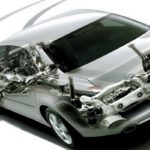Common concerns about 4 × 4 (4WD) drives

The following table shows the different types of transmission types. They are sorted by time of application and their function on off-road vehicles that can be encountered in our environment. As a basic example of comparison, the front-wheel drive IMT is given.
* The options in the table are not standard, but are only possible by removing one cardan.
Table clarification:
1. Drive only on the rear (or only front) wheels at normal speed.
It is used in standard asphalt driving and on good roads. If one wheel loses traction, the vehicle will not be able to continue moving.
2. Four-wheel drive at normal speed but across the center differential that splits power into front and rear driveshaft.
With this type of drive all the wheels are drive, but if one slips the other three wheels fit. It is applicable in all conditions, not all ATVs have it and is better than the number 1 option.
3. Recognition of the front wheels slipping by the computer and adding power with a special rear-drive blade.
This option is available for new vehicles.
4. Driving with four-wheel drive at normal speed but with a rigid link between the front and rear driveshafts.
If there is a central (middle) differential for this variant, it is blocked.
Used on slippery / soft roads. on snow, ice, mud, sand, as well as on uneven and bad roads. If one of the front and one rear wheels slips (loses traction), the vehicle will not be able to continue moving
This option is often misunderstood, namely, since the front and rear cardan are tightly coupled, the rpm sum of both front and rear rear is forcibly the same. The problem arises when turning where the front wheels travel longer than the rear wheels and there is a tendency to make a difference in the front and rear PTO rotation.
The consequences that can occur are:
- If the road is hard, the gearbox (every part of it) is overloaded, cardans, differentials, also joints, tires, steering system, suspension, consumption increases. Since no wheel can easily slip and erase that difference, it must be spent "by force" somewhere. At higher speeds, as with higher turning angles, the chances of destroying an assembly or tearing tires are also higher.
- When turning downhill or when turning at a higher speed, the vehicle tends to move in a straight line, because the rear wheels prevent the curve and push the front ones out of it. The effect is also proportional to the speed of movement.
5. Intermediate positionat fast (H - normal) and slow (L - reduced) speeds, there is no drive at all.
It is also used with a mechanical (PTO) winch, where the gearbox determines its speed, while the vehicle does not move, more precisely in place.
6. Reduced (L - slow) four-wheel drive via center differential.
Except for the speed, it works exactly the same as option 2. In this drive, the vehicle's power is increased. It is used on asphalt and hard terrain when slow movement or higher power is required. It is suitable for reversing with a trailer (because it saves the clutch).
7. Reduced (L - slow) four-wheel drive.
It works exactly the same as option 4, but at slower speeds, so all the downsides are less pronounced. Vehicle power is increased in this mode. In this mode, the vehicle gives maximum power and patency.
8. Reduced drive (2L) on rear wheels only.
It is useful when driving a trailer in reverse and when it is necessary to move slowly on hard terrain and when there is no need for all-wheel drive.
For LOCK / FREE locomotives 2L = 4L + locomotives for FREE.
For 4L AUTO locomotives without front PTO.
When switching between H and L (fast and slow), which includes options 5,6,7,8, you must stop the vehicle.
For all-wheel drive, all four tires need to be the same size.
Modern 4 × 4 SUVs are not covered in this text, as they mostly do everything from a computer, so the driver does not need to include anything special while driving.
However, if you prefer a direct connection between you, the vehicle and the terrain, then the classic 4 × 4 is the drive for you, and if used properly it will reciprocate your reliable work and driving pleasure.
Photo: Archive, Wikipedia
Written by: triodriver.com
Source: www.triodriver.com
Recommendation of similar texts:

Hi there, I am Mladen and I am an auto enthusiast. I started this blog years ago to help like minded people share information about latest cars, car servicing ideas, used car info, exotic cars, and auto technology. You will find helpful articles and videos on a wide variety of cars - Audi, Mercedes, Toyota, Porsche, Volvo, BMW and much more. Ping us if you have anything cool to share on latest cars or on how to make older cars more efficient, or just want to say hi!






